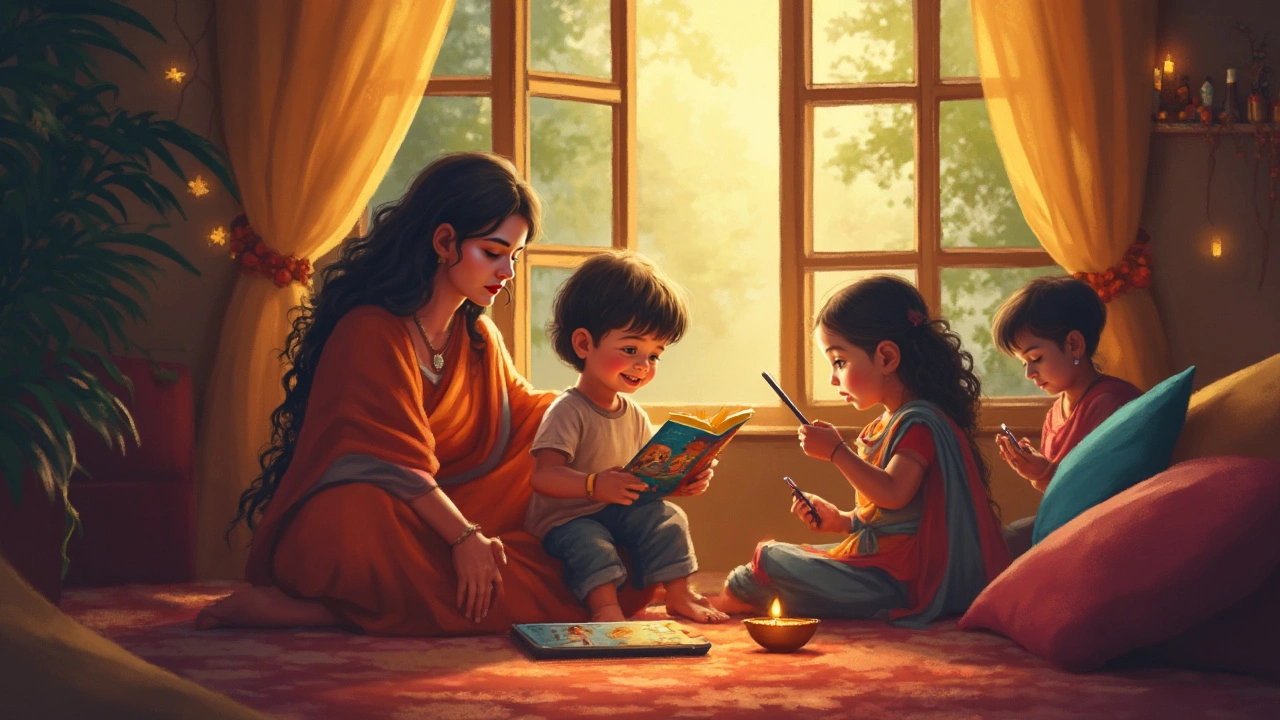Reading Trends: Why Is Reading Losing Popularity?
 Apr, 26 2025
Apr, 26 2025
You ever wonder why your phone seems to win the battle over a book almost every time? These days, stories compete with endless notifications, viral videos, and binge-worthy shows. The stack of unread novels on your nightstand isn’t judging you—most people are in the same boat.
Recent numbers can’t be ignored. A Pew Research survey in 2024 showed that nearly 40% of young adults in the US didn’t read a single book—physical, digital, or audio—in the past year. In 2011, that number was only about 20%. That’s a steep drop in a short time.
Why does this matter? Studies keep showing that regular reading helps improve your memory, lowers stress, and even boosts empathy. And yet, for many, it’s easier to scroll through social feeds than flip through print pages. The amount of content online just keeps growing, plus there’s always something shiny and new popping up on your screen.
If you’re finding it hard to carve out time for reading, you’re not alone. The way we use our time has shifted as digital habits have taken over. But understanding the problem is the first step, and there are ways to work reading back into your life—even if your attention span feels shot.
- Screens vs. Pages: The New Competition
- The Changing Attention Span
- What Kids Really Think About Books Now
- The Role of Schools and Parents
- Making Reading Fun Again
Screens vs. Pages: The New Competition
It’s impossible to talk about reading trends falling off without looking hard at screens. Think about how much time you actually spend looking at your phone, tablet, or laptop. According to Statista, the average American adult spends over 7 hours per day staring at screens. Compare that to the less than 20 minutes, on average, spent reading something for pleasure. That gap is growing wider every year.
The convenience of digital content makes it tough for books to compete. Need a quick answer or a laugh? TikTok and YouTube have endless options. Streaming services drop entire TV seasons in one go. Social media keeps refreshing with new memes and updates. Even news is now bite-sized, delivered in push notifications or Instagram stories. Books, by contrast, ask for more time and focus.
Here’s a look at how people use their screen time compared to reading time:
| Activity | Average Daily Time (2024) |
|---|---|
| Social Media | 2 hours 23 minutes |
| Video Streaming | 2 hours 48 minutes |
| Reading (for fun) | 17 minutes |
E-books and audiobooks were supposed to give book habits a boost, but even those are dwarfed by entertainment apps. People admit they start to read on their phone, then bounce to another app after a few minutes. The temptation is always just a tap away.
It’s not all doom and gloom, though. Some apps use competition and community—like Goodreads challenges or tracking streaks—to get people reading again. But the sheer amount of digital distractions is a huge reason why reading trends have taken a hit. If you’re struggling to pick up a book, you’re not broken—the odds (and algorithms) are just stacked against you right now.
The Changing Attention Span
Ever find yourself reading three pages of a book and then suddenly thinking about dinner, your phone, or something random? You’re not alone. Experts say our attention spans have shrunk over the last decade, mostly because we’re always jumping from one thing to another online. In 2015, Microsoft ran a study showing the average human attention span dropped to about 8 seconds—shorter than a goldfish. That number gets quoted a lot and, while it's a bit tongue-in-cheek, it’s backed up by how people actually act around content.
With so much digital noise, reading trends now show that folks—especially younger people—struggle to stay focused on longer texts. TikTok, YouTube Shorts, and Instagram Reels dish out bite-sized entertainment and info, training our brains to expect quick payoffs and frequent changes. A 2023 Common Sense Media report found that American teens spend more than 7 hours a day on screens, not counting schoolwork, and most of that time goes to short-form content.
When short, punchy posts and videos become your main media diet, finishing a whole book feels like a marathon. Here’s a simple breakdown of how tech is changing our brains and habits:
- Book habits have shifted toward audiobooks and podcasts—easier to consume in multitasking mode.
- Constant pings and notifications interrupt deeper reading, making it way harder to keep up with literacy goals.
- Reading stamina dips because our brains get used to quick scans instead of deep dives.
Check out this snapshot of reader habits in the past 10 years:
| Year | Avg. Books Read Per Year (Ages 18-29) | Avg. Daily Digital Content Time |
|---|---|---|
| 2014 | 8.5 | 3.9 hrs |
| 2024 | 4.2 | 7.4 hrs |
So, what can you do? Here are a few tips that actually help increase your attention span for books and articles:
- Start small—just 10-15 minutes a day on a physical or digital book, no distractions.
- Use the "do not disturb" mode when you read to block those constant interruptions.
- Break up long texts into manageable chunks. Chapter by chapter works fine.
- Try reading before bed, when digital screens are less tempting.
Digital distractions won’t disappear anytime soon, but you can retrain your brain for deeper reading—one page at a time.

What Kids Really Think About Books Now
If you ask most kids today about reading, you’ll probably hear responses like “It’s boring,” or “I’d rather play games or watch YouTube.” For a lot of them, books just don’t hold the same magic they might have for previous generations. It’s not just a gut feeling, either. A 2024 Scholastic Kids & Family Reading Report found that only 31% of 9–12-year-olds said they read books for fun at least once a week. Go back ten years, that number was almost half—45%.
The big competition? Digital distractions like TikTok, Instagram, and fast-paced games. These apps pack in quick rewards, which books can’t really match on the surface. Plus, kids say that reading “feels like homework” rather than something they’d choose to do in their spare time.
Here’s a look at what influences kids’ book habits right now:
- Fast entertainment: Videos and social feeds are short and give immediate payoff, while reading takes more time and focus.
- Peer pressure: If friends aren’t into reading, most kids drop it, especially by their early teens.
- The right books are hard to find: Kids are much more likely to read if they can pick stories that match their interests or favorite topics from movies and games.
- Negative school vibes: When reading is connected to assignments or tests, it stops feeling fun.
If you’re curious about what kids say they want from books, here’s some real feedback collected from a 2024 UK Youth Library survey:
| What Kids Want in Books | Percentage Mentioned |
|---|---|
| Funny stories or comics | 48% |
| Adventure and fantasy | 39% |
| Stories related to games/movies | 32% |
| Real-life relatable themes | 25% |
So why should parents and schools care about these trends? Because if the goal is to build solid literacy and get kids enjoying reading, the first step is listening to what actually gets them turning the pages. It’s possible to use digital trends instead of fighting them—graphic novels based on popular games or interactive stories can be a gateway. Simple move: encourage choice, ditch the judgment, and make room for stories that feel relevant to kids today.
The Role of Schools and Parents
If you ask most kids today what they read for fun, a lot will shrug—or mention a meme or TikTok caption instead of an actual book. That’s not just their fault. The way schools and parents handle reading makes a huge difference in building good book habits.
Schools used to rely on book reports and reading logs, but those don’t always turn students into lifelong readers. A Gallup report from 2023 showed that just 37% of US high schoolers say they enjoy reading "a lot." That's way down from 53% in the early 2000s. Part of the problem? Assignments often focus on testing, not enjoyment. Plus, required texts are usually decades old and don’t always connect with what teens care about today.
Some schools are stepping up. For example, "Drop Everything And Read" time in class (known as DEAR) gives kids space to pick the books they want. Another method: having teachers talk about what they’re reading themselves. When adults show excitement about stories, it rubs off. But not every school has room in the day for these activities, especially with so much pressure on standardized testing.
As for parents, their reading habits really matter. A 2022 Scholastic survey found that kids in homes where parents read often were twice as likely to say they like books "a lot." But plenty of parents are also caught up in endless screen time, so the example they set isn’t always helpful.
| Habit at Home | Chance Child Becomes Frequent Reader |
|---|---|
| Parent reads daily | 60% |
| Parent rarely reads | 27% |
If you're a parent or teacher, here are a few things you can actually do right now:
- Offer books that match the young reader’s interests, even if it’s comics or graphic novels.
- Read together, out loud, no matter the child’s age—this builds connection and curiosity.
- Leave books lying around the house or classroom where they’re easy to spot and grab.
- Talk about what you're reading, just like you might chat about a movie or a game.
- Limit screen time, but make sure to swap in reading time—don’t just ban devices.
Bottom line? Reading trends are deeply shaped by what kids see at home and in class. If adults don’t treat time with books like it matters, kids notice and follow suit.

Making Reading Fun Again
If reading trends keep sliding, what can you actually do to turn it around? Turns out, reading doesn’t have to feel like homework or another boring chore. You can make it fun again—even if your attention span feels like Swiss cheese these days.
Start simple: pick books or topics that match your interests. Don’t force yourself through a classic if you’re more into horror, sports, or anime. According to the U.S. National Endowment for the Arts, people are more likely to stick with books that connect to their hobbies or daily lives. Graphic novels and short story collections count too—a 2023 study found that readers who started with shorter reads were 45% more likely to finish a full-length book within the year.
- Try audiobooks while walking, commuting, or doing chores. Services like Audible and Libby are loaded with options, and you can even change the speed if you want to zip through faster.
- Join a book club—even online ones can make reading feel more like a social hangout than a solo activity. Reddit’s r/bookclub community added over 100,000 members in the past two years, so you’re nowhere near alone.
- Set small goals, like ten pages a day or one chapter before bed. This breaks reading into bite-sized, non-intimidating pieces.
- Swap your phone for a book for the first 15 minutes after you wake up or before you sleep. That little habit swap can add up to a few books a year without you even noticing.
Let’s get real—the environment matters, too. Put your book where you’ll actually see it (like your backpack or kitchen table), not buried on a forgotten shelf. And reward yourself. Maybe a treat, maybe an episode of your favorite show, after a reading session. You’d be surprised how well a little bribe works.
| Reading Hack | Reported Success Rate |
|---|---|
| Listening to audiobooks | 68% |
| Joining a book club | 55% |
| Reading before bed | 61% |
| Picking shorter reads | 74% |
Don’t take my word for it. As
Neil Gaiman put it: “The simplest way to make sure that we raise literate children is to show them that reading is a pleasurable activity.”That goes for adults, too. If you treat reading like a treat, rather than a to-do, it’s way easier to stick with it. And hey, every page you turn is a tiny shortcut out of the doomscroll trap.